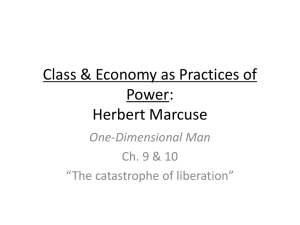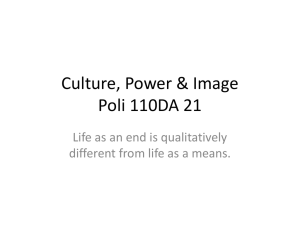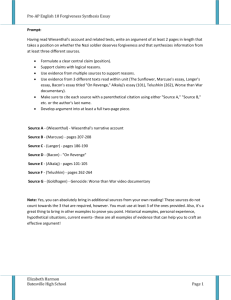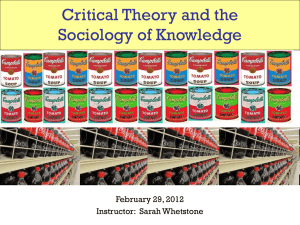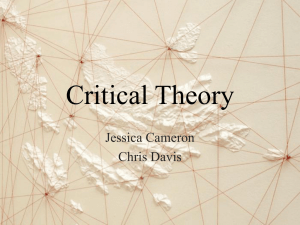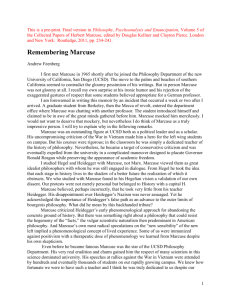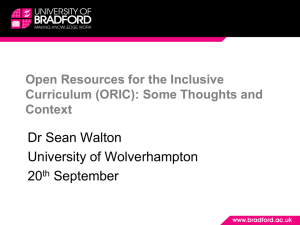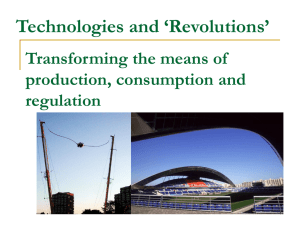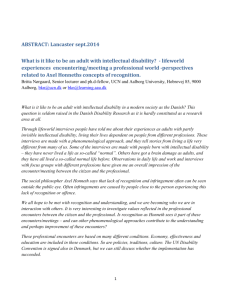Click here to see paper
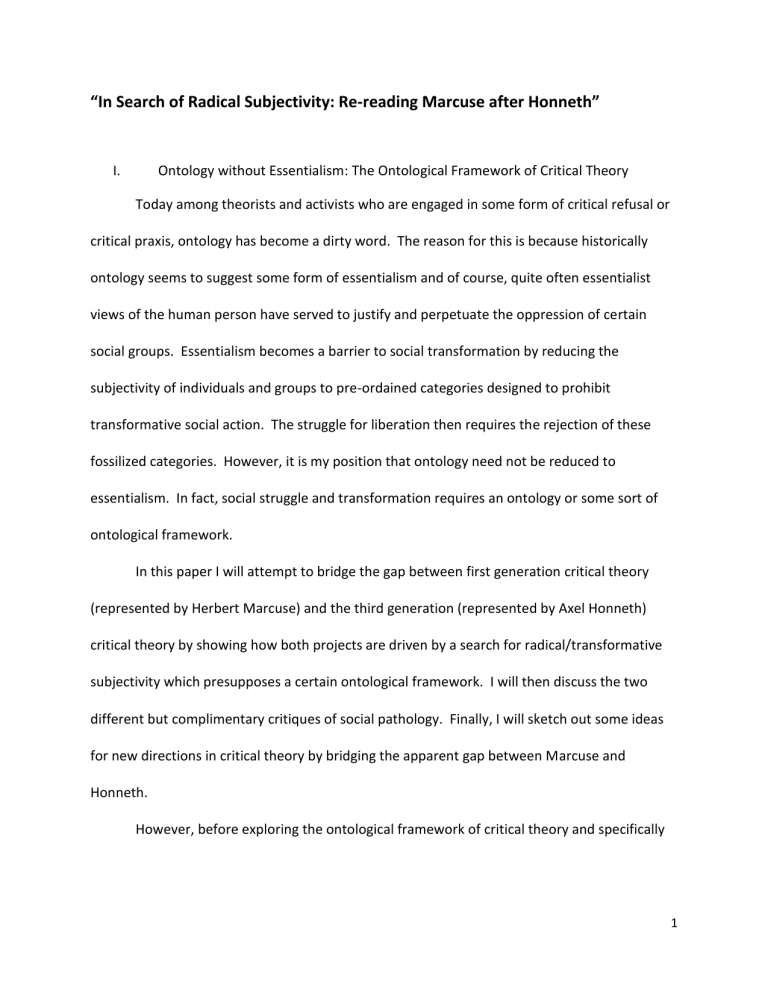
“In Search of Radical Subjectivity: Re-reading Marcuse after Honneth”
I.
Ontology without Essentialism: The Ontological Framework of Critical Theory
Today among theorists and activists who are engaged in some form of critical refusal or critical praxis, ontology has become a dirty word. The reason for this is because historically ontology seems to suggest some form of essentialism and of course, quite often essentialist views of the human person have served to justify and perpetuate the oppression of certain social groups. Essentialism becomes a barrier to social transformation by reducing the subjectivity of individuals and groups to pre-ordained categories designed to prohibit transformative social action. The struggle for liberation then requires the rejection of these fossilized categories. However, it is my position that ontology need not be reduced to essentialism. In fact, social struggle and transformation requires an ontology or some sort of ontological framework.
In this paper I will attempt to bridge the gap between first generation critical theory
(represented by Herbert Marcuse) and the third generation (represented by Axel Honneth) critical theory by showing how both projects are driven by a search for radical/transformative subjectivity which presupposes a certain ontological framework. I will then discuss the two different but complimentary critiques of social pathology. Finally, I will sketch out some ideas for new directions in critical theory by bridging the apparent gap between Marcuse and
Honneth.
However, before exploring the ontological framework of critical theory and specifically
1
the ontological framework in which Marcuse and recently Honneth have developed their theories, it would be helpful to briefly discuss the theoretical crisis to which they both responded. That is, the crisis of Marxism or historical materialism. The crisis of historical materialism is not one single crisis but several. There are two forms of this crisis in particular that I will address via Marcuse and Honneth in this paper. Each of these two forms of crisis give impetus to two forms of critical theory and their ontologies which are the focus of this paper.
The two forms of crisis to be discussed represent the two book ends of Marcuse’s career.
I must caution us at the beginning that although I will present these two forms of crisis here as two distinct historical moments, it would be a mistake to make too much out of this distinction. Although I locate the first crisis in the late nineteenth and early twentieth centuries, the period of the Second International 1889-1914 (even into the 1920s) it is the case that this crisis was never resolved and is still with us. And, although I locate the second crisis in the 1970s to the present, a form of it actually precedes Marxism. I will explain shortly. Lets take each separately.
The first crisis of historical materialism is multifaceted so I will focus on only two aspects of it that served as an impetus for the work of Marcuse and Honneth as well. The first problem is that of action or human agency, or, to put it another way, the problem of subjectivity. The second problem is that of a philosophical or normative foundation. The Orthodox Marxism of the Second International with its reduction of Marxism to scientific Marxism seems to have added to rather than remedied the problem of living in an oppressive, repressive society. That is, the subjectivity of individuals was put under erasure twice. First, subjectivity is put under erasure by the oppressive, alienating forces of capitalism. Secondly, by the notion that
2
revolution was inevitable combined with Lenin’s Vanguardism. It is more important for our purposes here to focus on the erasure of subjectivity due to capitalist oppressive forces.
Both Marcuse and Honneth begin their careers and critical theory projects with an attempt to rescue subjectivity, or human agency from determinism whether in its capitalist or
Marxist form, as well as attempting to provide critical theory with a solid foundation. For the early Marcuse it was a philosophical foundation for Marxism that was needed which would later guide his own version of critical theory. The rescue of human agency as well as the foundation for critical theory presupposes a certain ontological framework for each theorist. I will explore Marcuse’s ontology first.
II.
Ontology, Mutilated Subjectivity, and The Search for Radiacal Subjectivity in
Marcuse’s Critical Theory
In my view, Marcuse’s ontology in some ways puts him in the same camp with Adorno and Horkheimer and therefore makes him subject to the same criticisms that Honneth has directed toward Horkheimer and Adorno. On the other hand, there is something very different about Marcuse’s ontological framework that allows him to make certain modifications throughout his career that brings him closer to Honneth so that we may, and from my perspective, must, construct a fruitful dialogue between them. To this end, I will spend most of my time in this paper exploring the early works of Marcuse and Honneth as these works provide a certain trajectory of thought out of which their later works emerge.
This strategy then takes us to the Marcuse of 1928-1932, the student of Martin
3
Heidegger, who was in search of a philosophical foundation for Marxism. [discuss in note why this was necessary] I have a suspicion that the search for a philosophical foundation for
Marxism might not be all that different or at least not incompatible with Honneth’s quest for a normative foundation for critical theory. But, this is not clear. What is clear is that both theorists in the early part of their careers were in search of an action-theoretic model for
Marxism and critical theory. Let’s turn directly to Marcuse.
It is to be assumed that anyone who reads Being and Time and is so inspired by it that they go to Freiburg to study with Heidegger is or will be committed to some form of ontology.
What has to be clarified here is the nature of Heidegger’s as well as Marcuse’s ontology,
Marcuse’s specific use of it, his development beyond Heidegger’s ontology, and the role that it plays in the quest for radical subjectivity. At the center of the ontological framework of
Heidegger and Marcuse is the concept of historicity (Geschichtlichkeit) happening. As John
Abromeit tells us in the glossary to Heideggerian Marxism, “For Heidegger, and for Marcuse during this time as well, “ontology” does not signify a realm of eternal truths that exist outside of history and are unaffected by the passage of time.” [p. 185] Abromeit rightly claims that for
Heidegger, “ontology” is through and through historical. In her introduction to the English translation of Hegel’s Ontology and Theory of Historicity Selya Benhabid writes:
We can see now that one of Marcuse’s main purposes is to uncover the intrinsic relation between historicity and Spirit, temporality and Life, in Hegel’s work. In undertaking this task, Marcuse may have been inspired by a criticism of Hegel voiced by Heidegger in
Being and Time. Heidegger maintains that Hegel had established merely an “external” and “empty formal-ontological” equivalence between time and Spirit, “by going back to
4
the selfsameness of the formal structures which both Spirit and time possess as the
negation of negation. Heidegger is particularly critical of Hegel’s phrase that “Spirit falls into time,” which he claims obscures the fact that Spirit is already in time. [p. xxv]
There are two points that I would like to make in passing here and return to later. First, like
Heidegger, Marcuse will criticize Hegel’s philosophy for its abstractness and its flight from historicity. He will also direct this same criticism toward Heidegger later. Secondly, the early
Marcuse and Honneth as well found that Hegel’s notion of Life (which later was replaced by
Spirit) as more helpful for the development of their action-theoretic forms of critical theory.
What is important here is first, the ontology or ontological framework that the young
Marcuse partially takes over from Heidegger does not render human beings nor the human condition as static or unchanging. So, from the beginning, when Marcuse uses the Marxian language of human essence, he is not referring to some set of fixed, eternal properties. Hence, in his Marxism and Deconstruction Michael Ryan misses the mark a bit when he claims that:
Marcuse’s critical theory and Derrida’s deconstruction are compatible in that each promotes a negative thinking that destabilizes the apparently stable positivity of the world – its facticity. Each thinker conceives the world as being constituted by an inherent negativity or contradiction. To dissolve the hegemony of common sense, which is enslaved to facticity, Marcuse believes one must flush out the immanent contradictions of reality. For this project, it is necessary to develop a logic and a language of contradiction. Derrida might agree with Marcuse’s strategy, but he would
5
probably find the goal of Marcuse’s logic of contradiction – the making present of an absent, true essence – less acceptable. [p 70-71}
It seems to me that the error found in the last sentence of the above passage stems from two problems. First, Ryan seems to not fully understand Marcuse’s project as a whole.
That is, he gets bogged down with the letter and not the spirit of Marcuse’s writings. When
Marcuse talks about human essence, he seems to have in mind something like unrealized human potential, or optimum living for individuals in a given society. What this human potential is cannot be separated from the present historical conditions wherein a certain actuality (facticity) makes possible a certain potentiality. The potential for a certain form of human liberation and form of life is rooted in the present social facticity. Hence, the “absent” that is to be made “present” is to some degree already present but restrained or contained.
Indeed, while certain social developments provide us with the tools for a qualitatively better form of life (which most of us desire) it also provides the mechanisms for the restriction of the form of social change that is geared toward liberation. Therefore, even Marcuse’s use of terms like “essence” must be historicized.
It is on the basis of social contradictions, the tension between liberation and oppression that Marcuse was preoccupied with the “radical act”, that act that can only be made possible by the very historical moment and social configuration that is to be overcome. So, one can argue that there are historical and social conditions that make possible a certain form of subjectivity, an emancipated subjectivity. Yet, these same historical and social conditions produce the institutions, values, belief systems, and practices by which subjectivity is mutilated.
We see here the nature of dialectical thinking as employed by Marcuse. It is Marcuse’s dialectic
6
that also protects him from the criticism that Honneth level against early Frankfurt School critical theory. For example; as capitalism develops it produces resources that are plentiful enough so that the needs of all members of a society can be met. It also produces culture, educational institutions etc. In short, capitalism tends to produce all of the tools for its own undoing. However, as it produces these tools and resources it must also hinder the development of critical thinking. Our capacity for critical thought and our understanding of our own needs are mutilated via some form of ideology and the internalization of the values of those who benefit from the uneven distribution of resources. Although the notion of mutilated subjectivity and the function of ideology in the whittling down of critical consciousness makes
Marcuse sound like Horkheimer and Adorno, this is only one side of the story, as we will see later when we discuss Marcuse’s on going search for the possibility of radical subjectivity.
At this point I want to do two things. First, we must look at the way in which Marcuse departs from Heidegger’s ontology. Secondly, we must look at the modified ontological framework that the early Marcuse shared with Horkheimer and Adorno but later modifies again. Marcuse went to Freiburg to study with Heidegger because he believed that he had found in Heidegger’s Being and Time a “concrete philosophy” on which to reconstruct Marxism.
However, Marcuse would later see this as a mistake.
But I soon realized that Heidegger’s concreteness was to a great extent a phony, a false concreteness, and that in fact his philosophy was just as abstract and just as removed from reality, even avoiding reality, as the philosophies which at that time had dominated German universities, namely a rather dry brand of neo-Kantianism, neo-
Hegelianism, neo-Idealism, but also positivism. [p. 166 heid Marxism]
7
As Abromeit and Wolin point out in their introduction to Heideggerian Marxism, Marcuse believed that Heidegger took an approach that rendered him incapable of transitioning from the ontological plane of analysis to the ontic or historical plane. Hence, Heidegger’s historicity is a false historicity.
The problem here is that at the ontological level of analysis Heidegger simply explores the being for whom Being is a question or a problem. At this level of analysis Heidegger explores the fundamental structures of Dasein. That is, under what conditions, in what structural form does Dasein live, move, and have its being? Heidegger examines several features of everyday Dasein, falleness, being toward death, idle talk, boredom, care, curiosity, etc. What has been disclosed here are mere universal conditions or modes of existence in which Dasein happens and experiences happenings. However, even these universal modes of being are experienced in particular ways at specific times with varying levels of intensity. They have a social and historical context that shape experience. The interpretation that we give to these modes of being and our orientation toward the world as we are in these modes is the work of a specific social and historical configuration. In the translators introduction to Hegel’s
Ontology and Theory of Historicity Selya Benhabib explains the distinction between the ontological and the ontic as follows:
In posing the question of the mode of Being of the historical, then, Marcuse is asking what those presuppositions are that lead us to experience and interpret historicity as a mode of “being as.” We can thus distinguish two levels of inquiry. At the level of everyday experience and interpretation, history means something for us and we live through it, we experience it in a certain way. We are surrounded, as Dilthey has
8
expressed it, by objects, buildings, artifacts, and institutions that are in the process of perpetual historical becoming. This is the ontic level of the existence of individual beings as “such and such,” “thus and not otherwise.” This ontic level of meaning and experience “always already” presupposes an “orientation” to Being, an orientation that is the fundamental component of the world within which any Being comes to be and is experienced as what it is. This is disclosed by the ontological level of investigation. [p. xx hegels ontology]
While Hegel’s Ontology and the Theory of Historicity functions at the ontological level of analysis, Marcuse’s ultimate concern is at the ontic level. The ontological level merely provides a foundation for setting up the analysis of Dasein at the ontic level. After Hegel’s Ontology the rest of Marcuse’s work is carried out at the ontic level, a level that Heidegger opens up but then avoids. This focus on the ontic level is the decisive departure from Heidegger.
Marcuse claims that at the ontological level where Heidegger’s analysis remains history is neutralized. He says of Heidegger, “He makes it into an existential category which is rather immune against the specific material and mental conditions which make up the course of history.” [p. 168 heid Marxism]
At the ontic level Dasein is examined as separate distinct Daseins/Daseinen in its concrete historical situation. Dasein has a race, a gender, a class, and on the basis of its situation and social identity it has concerns that are specific to the form of Dasein that it is. It is worth citing
Marcuse at length here:
9
There most certainly is a need for such an analysis, but that is precisely where the concrete conditions of history come in. How does the individual situate himself and see himself in capitalism—at a certain stage of capitalism, under socialism, as a member of this or that class, and so on? This entire dimension is absent. To be sure, Dasein is constituted in historicity, but Heidegger focuses on individuals purged of the hidden and not so hidden injuries of their class, their work, their recreation, purged of the injuries they suffer from their society. The Man (the anonymous anyone) is no substitute for the social reality. [p. 169 heid marx]
Heidegger’s analysis of historicity and the fundamental structures of Dasein are incomplete insofar as the concrete day to day forms of concern or care in their specific daily manifestations literally fade into nothingness. The specific manner of Dasein being – with – others is omitted from Heidegger’s analysis. Dasein is always with others in a specific way whether negative or positive. Dasein loves and hates, it enslaves and is enslaved, Dasein rapes and is raped, murders and is murdered, recognizes and misrecognizes, Dasein oppresses and struggles for liberation etc.
The second issue that I will deal with here is the ontological framework that Marcuse shared with Horkheimer and Adorno. This is important here because it becomes the focal point of Honneth’s critique of the early Frankfurt School. I will mention it briefly here because the next section will focus on Honneth’s critique of this framework.
Even before parting company with Heidegger Marcuse was concerned with the problem
10
of labor. Remember, part of his interest in historicity is to seek out the necessary conditions for the radical act whereby society would be transformed. In his early essay, “Contributions to a
Phenomenology of Historical Materialism” Marcuse writes:
Let us now sketch out a brief outline of the Marxist fundamental situation: its central concern is with the historical possibility of the radical act—of an act that should clear the way for a new and necessary reality as it brings about the actualization of the whole person. Its standard—bearer is the self-consciously historical human being; its sole field of action is history, revealed as the fundamental category of human Dasein. Thereby, the radical act proves itself to be the revolutionary and historical action of “class” as the historical unit. [p. 3-4 heid Marxism]
The question here is that of the revolutionary situation, the moment of possibility for the radical act, and the revolutionary agent. Marcuse states:
The question of radical action can only meaningfully be posed at the moment when the act is grasped as the decisive realizations of the human essence and yet when, at the same time, precisely this realization appears to be a factical impossibility—that is, in a revolutionary situation. [p. 4 heid marx]
That the “act” is grasped as the decisive realization of the human essence suggest that in the
“act” Dasein, the human agent, asserts him or herself as one who is no longer merely thrown into existence, but rather, as one who throws. This is the moment of self-consciousness when one consciously takes up one’s life, one’s situation and transforms them, thereby transforming one’s relations and society as well. It is the conscious attempt to overcome the contradictions
11
of one’s situation. However, such an act is made impossible by reifying forces that transform personal powers into thingly ones.
Here Marcuse seems to be operating from a synthesis of the Heidegerrian notion of theyness in its negative sense (lost in the they) and the Marxist notion of the division of labor, alienation, and fragmentation. He writes:
Surveying the concrete historical situation, one sees an endless sum of activities, one next to the other, and each inextricably bound and determined by the other. All of these activities seem to be detached from the human actors who, in turn, do not seem to live in them, but merely to be occupied with them; or—the ultimate absurdity—one sees actors carrying out actions not to live, but for the sake of mere survival! Here one sees the “transformation of personal powers into thingly ones,” and what is left behind is an “abstract individual […], robbed of all life-content,” whose “own deed becomes an alien power opposed to him.” [p. 4 heid marx]
It is against this form of capitalist activity that the radical act is called for, to rescue the human from an inhuman existence, existence as a thing. Here again we see the fusion of Marx and
Heidegger. Marcuse will work his way toward a universal Dasein (subject) but in a way that differs greatly from Heidegger. Heidegger explores the fundamental structures of general
Dasein. Marcuse begins with a specific form of Dasein and its distinct place in a fragmented society. Marcuse turns his attention to a Dasein who is the victim of reification, thingification, dehumanization, etc.
However, this very situation, the expansion of social reproduction, with “spatial
12
expansion, commerce and conflict with other societies,” the division of labor within societies etc., produces the conditions for its own undoing. Marcuse claims that it is here that “class arises as the unifying force driving history”. [p. 8] Even national divisions are overcome as the development of the forces of production transform the national division of labor into an international one. “The “comprehensive dependency” of the individual’s historical existence into a world-historical one: the “transformation of history into world history” is complete”. [p.
8] We have now discovered the bearer of the radical act.
In the historical situation that we have been addressing, class is the decisive historical unity and the knowledge of the unique, historical-social necessity is the achievement of
“class consciousness.” In class consciousness, the chosen class arises to become the bearer of the historical act. Should the revolutionary situation be at hand, it can only be seized by that class that is conscious of its historical situation. [p. 9 heid Marxism]
In the above passage we have a picture of how things are supposed to develop according to the Marxist theory of revolution. However, it did not take Marcuse long to figure out that counter-revolutionary forces were quite pervasive. From the 1940s onward he began to use the term “social change” as well as revolution. In the 1940s he and Franz Neumann began work on a theory of social change that Marcuse would continue to develop and modify in light of concrete social and political happenings. I will argue later that it is his later theory of social change that protects him from Honneth’s criticism and provides a bridge between he and
Honneth.
III. Ontology, Misrecognition, and the Search for Transformative Subjectivity in Honneth’s
Critical Theory
13
In the past couple of decades third generation critical theory has largely been influenced by Axel Honneth’s theory of recognition. Honneth’s theory has been received with great admiration and support by some and with great hostility by others. The hostility has come from a wide range of theorists with varying philosophical commitments. I would like to focus on those who reject Honneth’s theory on the basis of a defense of early Frankfurt School critical theory. Embedded in my examination of Honneth’s theory is also a criticism based on what I take to be a thin engagement with Marcuse. I will argue that Marcuse does not quite fit into the paradigm of early critical theory criticized by Honneth. I will not explore Honneth’s theory of recognition in much detail here as I have done that elsewhere. Nor will I spend much time examining his later works. What I want to do here is open up a path for understanding place of recognition within the context of the critical theory project and then open the door for a richer conversation between Honneth and Marcuse.
Like Marcuse, Honneth’s project is grounded in a search for radical (or in Honneth’s case transformative) subjectivity. Although Honneth’s approach differs from Marcuse’s as does the social and historical context from which his work emerges. There are two specific problems that Honneth faced as a young theorist that are closely connected. Both of these problems conjointly form the crisis of historical materialism of the 1970s and are also embedded in early
Frankfurt School critical theory. The first is the problem of radical or transformative subjectivity. Put another way, the problem of revolutionary agency. The second problem is that of the reduction of human action to the labor paradigm. Honneth’s worry was that early
Frankfurt School critical theory failed to solve these problems. In fact, transformative
14
subjectivity undergoes further erasure. So, while Marcuse begins his project with the search for the grounds for the radical act, Honneth begins in search of an action-theoretic model for grounding critical theory. We must first take a look at Honneth’s critique of the early Frankfurt
School and then explore the social ontology that provides the basis for his action-theoretic model of critical theory as well as his theory of recognition.
Honneth’s critique of the Frankfurt School coincides with his and Habermas’s critique of
Marx. The ontological framework from which Honneth’s theory emerges is an action-theoretic anthropology. In his first book Social Action and Human Nature, co-authored with Hans Joas,
Honneth seeks to develop a philosophical anthropology that expands and deepens Marx’s claim in the German Ideology that “circumstances make men as much as men make circumstances.”
The latter part of this statement is prioritized by Honneth insofar as he seeks to examine the way human beings move and shape history. This leads to an attempt to connect critical to a certain form of German anthropology on which they may develop a theory of human action.
However, anthropology must not be seen as support for essentialism. Again, we have a nonessentialist ontology. Honneth and Joas write:
However, anthropology must not be understood as the theory of constants of human cultures persisting through history, or of an inalienable substance of human nature, but rather as an enquiry into the unchanging preconditions of human changeableness.
These unchanging preconditions of human changeableness cannot, though, simply be factually ascertained; they are not evident in nature. They present themselves only in
15
the form of reconstructed inceptive conditions of species’ history and of the individual’s development. [p.7 social action and human nature] [develop]
Honneth’s version of critical theory is an attempt to rescue and extend the Marxian notion of world-forming praxis as well as developing a normative foundation for critical theory.
The problem Marx and the early Frankfurt School have in common is that their critique of western society was limited to the labor/economic framework. The specific problem with the
Frankfurt School is that their version of critical theory is based on a comprehensive philosophy of history which interprets human history and activity as an expanding, nature-transforming productive activity. Hence, scientific knowledge develops only in the human quest to dominate and control nature. This critique of the Frankfurt School is continued in Honneth’s The Critique
of Power. I will address each of these criticisms and then explore the development of
Honneth’s theory of recognition as a response.
Following Habermas, Honneth recognizes that while Marx’s philosophy, in certain places, point toward a possible theory of human communication and interaction, this possibility does not come to fruition. Instead, Marx seems to reduce all human action to the labor process. According to Honneth, the early Frankfurt School follows Marx in this reduction of human action to the labor paradigm. The dominance of the labor paradigm also reduces all human struggle to labor/economic struggles. Honneth argues that this focus derails the emancipatory goal of critical theory. It derails the project of critical theory in two ways. First, the reduction of all human struggle to the labor paradigm leads Hokheimer and Adorno to develop a theory of instrumental rationality that closes off any possible resistance. Capitalist
16
society becomes the fully administered society immune to the work of critical consciousness.
Secondly, Horkheimer and Adorno fail to address other human needs that transcend economic needs. This failure causes them to be unaware of the social struggles that many social groups are engaged in. These non-economic struggles disclose a resistance to the completely administered society. The Civil Rights Movement in the US for example; was a struggle against the fully administered society. The feminist movement is another such movement. The question now is does Marcuse fit into the model of critical theory that is criticized by Honneth?
The answer is yes and no. The early Marcuse fits much more so than the later.
In his 1933 essay “On the Philosophical Foundations of the Concept of Labor in
Economics”, Marcuse claims that “labor is an ontological concept”. [p. 124] That is, labor is the fundamental mode of action in human existence whereby the human being is constituted through its interaction with nature. Marcuse is still working within the Hegelian/Marxian paradigm of expressionism or objectivisation whereby the human will expresses or objectivizes itself by controlling and re-shaping nature. The point of Marcuse’s essay is to rescue the concept of labor from economic theories that reduced labor to economics. Marcuse’s argued for a much broader and creative notion of labor. In traditional economics the role of labor in the constitution of the human subject is omitted. For Marcuse, labor is a form of praxis that includes but also transcends merely “making provisions” at the level of biological necessity.
However, in traditional economics and in capitalism this broader function of labor is ignored.
As a result, the self-creative process in which the human being is constituted under goes erasure. Marcuse writes:
17
Labor is losing its authentic meaning beyond material production and reproduction as well. It is no longer essentially connected to the real happening, the real praxis of
Dasein. It can no longer fulfill its highest possibility, which is to intervene in the happening of the totality of Dasein in order to give it meaning and purpose. Robbed of its full reality as praxis, labor does in fact reach the point where it is no longer labor in the final sense; it now only accompanies labor, follows it or precedes it (without solid ground). [p. 150] [develop] [see arendt]
Marcuse’s point is that Human activity or praxis has a freedom dimension is not recognized by labor in its mere economic form. Labor has been reduced to the realm of necessity which has been severed from the real of freedom.
Although the early Marcuse develops a form of critical theory that is still contained within the labor paradigm like that of Horkheimer and Adorno, his theory recognizes the emancipatory potential of labor. Honneth is aware of this in his 1980 essay “Work and
Instrumental Action: On the Normative Basis of Critical Theory”. In juxtaposing the positions of
Marcuse, Sartre, and Lukács, to Adorno and Horkheimer he says of the former:
This subject then assumes the same conceptual role that the individual working subject had previously occupied. In this version, then, the concept of emancipation through work requires a monolithic concept of the revolutionary proletarian subject which is no longer bound to actual work experiences in the industrial plant. [p. 37 fragmented world of the social]
18
This attitude in Marcuse ties in with our earlier discussion of the role of the universal class as the bearer of the radical act. Hence, even though the early Marcuse, like Adorno and
Horkheimer, operates within the labor paradigm and also recognizes the instrumental role of labor he does not succumb to the same form of reductionism as his two colleagues. That is, his entire project seeks to re-establish the realm of freedom. He seeks to recover the self-creative, emancipatory function of labor.
Horkheimer and Adorno will both go in a different direction altogether. Honneth’s argument is that Horkheimer and Adorno seem to abandon the project of critical theory and move toward a philosophy of history which sees history as the further development of oppressive forms of technological domination. Labor is no longer interpreted as a selfformative process, but rather, as mere self-preservation. As such, labor must be viewed in opposition to nature, as the attempt to control and dominate nature. Human reason stands in the service of self-preservation and the domination of nature. [p. 34 the critique of power]
From the time of the writing of Dialectic of Enlightenment onward the obsession of Horkheimer and Adorno with instrumental reason prohibits the development of a theory of the normative function of reason. Honneth’s main concern is that the theories of Horkheimer and Adorno leave no room for a theory of human action. His goal is to found critical theory on a theory of human action.
It is here that Honneth turns to the theory of recognition. Honneth attempts to develop the insights of the young Hegel as presented in Hegel’s Jena philosophy of 1801-1806 and especially the 1802-1803 System of Ethical Life as well as the insights of G.H. Mead and object
19
relations theory. He does not follow the popular tendency to follow the Hegel of the
Phenomenology of Spirit because from 1806 onward Hegel falls into a type of speculative idealism or metaphysical thinking that does not take into consideration the real concrete moral grammar of social conflict. Like the young Hegel, Honneth is critical of the tradition of social/political philosophy that follows Hobbes and Machiavelli in locating the origin of political institutions in the struggle between individuals for self-preservation. The establishment of institutions that are supposed to guarantee freedom is generated by struggles for recognition.
By making the move to the early Hegel Honneth has moved critical theory away from the framework of labor as mere self-preservation. Honneth’s theory of recognition focuses on human needs that may intersect with physical (material) needs but are not reducible to such.
These needs are those that must be met if human beings are to develop any sense of well-being and flourish as autonomous moral agents.
This sense of well-being and autonomy requires an intersubjective process of development. While early critical theory had inadvertently put human agency and subjectivity under erasure, Honneth has tried to rescue human agency via a theory of human action that traces transformative subjectivity to the very conditions of the formation of subjectivity in human community. This move reveals the ontological and normative foundation of Honneth’s critical theory. In Social Action and Human Nature where he and Hans Joas attempt to found historical materialism on an anthropology of human action, the idea that anthropology is an
“enquiry into the unchanging preconditions of human changableness” is a search for the
20
ontological and normative conditions of subject-formation. The theory of recognition that later follows is a development of the theory of these “unchanging preconditions”.
In a nutshell, rational human development requires three forms of recognition. These three forms of recognition are basic human needs that include but go beyond the material need for self-preservation. They are also three types of normative relations and interactions without which the human being will fail to achieve autonomy and self-actualization. Human history may be viewed as the ongoing struggle by certain social groups for the actualization of these three forms of recognition. Here, I will simply mention each of the three forms of recognition without trying to defend them since that would take us beyond the scope of this paper.
The three forms of recognition are three forms of self-relation that make autonomy, self-determination, and self-development possible. The first form of self-relation is selfconfidence which is the ability to freely articulate one’s needs and have those needs taken seriously. This form of self-relation corresponds to love or care and is usually provided by a small and close circle of individuals such as the family. The second form of self-relation is selfrespect. This form contains the structural core of ethical life insofar as it produces that confidence in individuals which is required for autonomous participation in public life. It is this context that we struggle for political rights. Autonomous participation in public life requires rights that are recognized by all other members of that society. The third form of relation-toself is self-worth. Here, one must be certain of the value of his or her capacities. The focus here is on differences rather than sameness, particularity or individuality rather than universality. In a Marxist context, the worker seeks much more than self-preservation from her
21
work. She wants to be treated as if her work is of value to society and makes an important contribution. This form of recognition overcomes the problem of alienation to the extent that the worker is not treated as a mere instrument for the use of another individual. Under this form of recognition the worker is respected and properly compensated for her work. Hence, the house keeper feels as important as the doctor.
In a given society it is possible and is often the case that these forms of recognition are withheld. The withholding of any one of these forms of recognition is itself a form of social pathology that may produce further pathologies in the denied individual. According to
Honneth, human history has been a series of struggles by groups who have been denied one or more of these forms of recognition. It is in making this claim that he goes beyond the critical theory of Horkheimer and Adorno. That is, human are not and have never been locked into an iron cage of rationality but have always struggle against it. It is the task of critical theory to identify these struggles and aid in the process. It is this way of thinking that may serve as a bridge between Honneth and Marcuse.
III.
Where is Marcuse in Honneth’s Reading of the Frankfurt School?
With the exception of one article that I know of “Herbert Marcuse und die Frankfurter
Schule” and a few mentionings here and there, there seems to be no direct, sustained engagement by Honneth with Marcuse. His critique of Horkheimer, Adorno, Habermas, and a few other theorists outside of the Frankfurt School, such as Michel Foucault has been quite
22
extensive. For some reason, Marcuse seem to remain on the sidelines coming into the game once and a while to punt or relieve an injured player. When Marcuse is mentioned he is quite often lumped into the same category as Horkheimer and Adorno. There is some justification for this. However, I remain suspicious of this sidelining of Marcuse. It seems to me that the best explanation for this is that Marcuse does not quite fit into the model of critical theory that
Honneth is critical of. In fact, despite some big differences, Marcuse may be closer to Honneth in some ways. Unlike Horkheimer and Adorno, Marcuse’s critical theory does not lead us into the political paralysis of total domination and total administration. Unlike Habermas, Marcuse does not naively separate the sphere of instrumental rationality (system) from the sphere of communicative rationality (life-world).
Marcuse’s project is more radical than that of Habermas insofar as it takes seriously the role of domination and instrumental rationality at the level of the economic and political system as well as in the life-world. It is more radical than the projects of Horkheimer and
Adorno to the extent that the quest for radical subjectivity is never abandoned. In fact, it is this tireless search for radical subjectivity that undergirds the vicissitudes of Marcuse’s critical theory. This is especially true of the Marcuse of the 1960sthe 1970s. Well before the theory of recognition is fashionable or enters into the discourse of critical theory, Marcuse began to identify various struggles for recognition and social justice as the ground upon which critical theory must develop. In this context of the 60s and 70s and the birth of the New Left Marcuse begins to move beyond the labor paradigm. Social change may not exclude the revolutionary activities of the proletariat but it cannot be reduced to the activities of the proletariat. Marcuse
23
recognized that we must begin to look in different places for the catalyst to social change. The introduction of the concept of “catalyst groups” in An Essay on Liberation, his 1974 essay
“Marxism and Feminism” as well as several small works suggest that Marcuse’s thinking was moving in a direction that would coincide with recent theories of recognition. For the later
Marcuse, emancipation could not be reduced to the labor framework. He recognized the role that needs beyond our material needs played in the revolts at that time.
Today, part of the interest in the theory of recognition is generated by recent multicultural and diversity initiatives, identity politics, and politics of difference. For many contemporary theorists these struggles are historically very recent. Following this view would put Marcuse’s later works at the beginning of these recent movements. Hence, we can then think of Marcuse as having stood at the opening of these new struggles for recognition.
However, I am inclined to agree with Honneth’s view in opposition to Nancy Fraser, that struggles for recognition are not recent but have been around for centuries. There is no time here to get into that debate. My agreement with Honneth here does not jeopardize what I am trying to show regarding Marcuse’s critical theory. How old struggles for recognition are is irrelevant. My first point is that Marcuse’s critical theory developed in a direction that in some ways protects him from the criticisms of the Frankfurt School by Honneth. My second point is that there is enough of a difference between Marcuse and Honneth that the future of critical theory cannot avoid a serious confrontation between the two thinkers.
For instance, I am not ready to abandon Marcuse’s theory of one-dimensionality. This
24
might seem puzzling since it is this part of Marcuse’s theory that seem to resemble the theory of total domination developed by Horkheimer and Adorno. However, this is not out of step with what I’ve been trying to show here since Honneth himself connects his theory to that of the Frankfurt School as an examination of social pathologies. Honneth takes seriously the pathology of misrecognition and the long-term consequences. The Honneth/Marcuse conversation would have to include an analysis of the social mechanisms that produce various form of misrecognition. This would require something like a theory of one-dimensional thinking. That is, we have to examine the way in which structures and systems of misrecognition maintain themselves and protect themselves against protest. Finally, Honneth’s notion of social struggle does require action by the oppressed but it does not signify success. I think that the very notion of struggle must be critically examined. In Honneth’s theory it sounds as if social groups are unified in their struggle for recognition against other groups.
However, there are members of misrecognized groups who resist struggle and quite easily conform to structures of misrecognition.
The search for radical subjectivity remains a search because such subjectivity continues to be paralyzed by misrecognition, one-dimensional thinking and repression. Honneth has provided us with great new theoretical tools for recognizing the possibility of transformative subjectivity in social struggles for recognition. However, we must turn to Marcuse to understand the “conquest of the unhappy consciousness” in these struggles.
25
IV.
Where is Marcuse? Honneth’s Reading of the Early Frankfurt School
V.
Marcuse after Honneth: New Directions for Critical Theory
26
